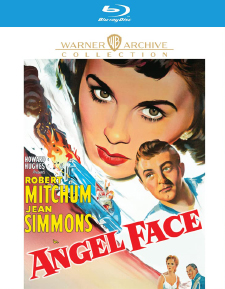Angel Face (Blu-ray Review)

Director
Otto PremingerRelease Date(s)
1953 (June 27, 2023)Studio(s)
RKO Radio Pictures (Warner Archive Collection)- Film/Program Grade: B-
- Video Grade: A-
- Audio Grade: A-
- Extras Grade: B-
Review
There doesn’t seem to be a consensus regarding Angel Face (1953), a film noir produced at RKO and directed by Otto Preminger. It received mix-to-negative reviews when it was new, but in more recent years several prominent critics, particularly the late Robin Wood, championed it. I found it underwhelming, a patchwork of elements from earlier, better film noir, though Robert Mitchum and Jean Simmons, its two stars, give good performances.
Late one evening ambulance drivers Frank Jessup (Mitchum) and Bill (Kenneth Tobey) rush to the then still-remote area above Beverly Hills, to the cliffside estate of Charles (Herbert Marshall) and Catherine Tremayne (Barbara O’Neil). The latter, in bed, is treated for gas inhalation stemming from a gas fireplace mysterious turned on, its key lost then found deep in the fireplace. Catherine, nearly hysterical, insists that it wasn’t accidental nor was she attempting suicide, but rather that someone was trying to murder her. No longer needed, Frank and Bill prepare to leave, but Frank is drawn to Catherine’s beautiful stepdaughter, Diane (Simmons), apparently distraught by her stepmother’s near-death experience.
Later, at a roadside diner where Frank is trying to phone his girlfriend, hospital receptionist Mary Wilton (Mona Freeman), Diane turns up and begins flirting with Frank. She learns of former race car driver Frank’s dream to buy his own garage with Bill. Soon after, Diane makes a lunch date with Mary, a total stranger, offers them a gift of several thousand dollars toward the garage, and when Mary, suspicious of Diane’s motives, outright rejects it, Diane makes it plain that she has her eyes on Frank and may the best girl win. Later still, Diane convinces Frank to go to work as the family’s chauffeur. Frank, who takes life as it comes, agrees based on the higher pay and better opportunity to fool around with Diane.
The movie audience gradually learns more about the family dynamic. Charles had been a famous, respected writer who lost his first wife in the London Blitz. Upon marrying wealthy Catherine, he developed complete writer’s block from which he never recovered. He relies on an allowance provided by his wife, an allowance he mostly spends spoiling his adult daughter. Diane, for her part, is outwardly friendly toward Catherine but inwardly obsessively resentful.
Incorporating elements of Double Indemnity, Out of the Past, Laura, and even A Place in the Sun in some respects, experienced film noir viewers will likely find Angel Face woefully familiar; even in its two big “shock” scenes are easily predicted.
What’s (a little) different this time is that the “bad girl” is an almost mousy, brunette English girl of just 20, she not particularly motivated by money, and that he doesn’t become fatally yet knowingly obsessed with her. Indeed, Mitchum’s Frank seems to spend half the film’s running time leisurely packing his suitcase, intending to walk away from a girl and a situation in which the primary emotion at his end is ambivalence. The film is mildly confused in this area; at one point, Frank naively tries to win Mary back, suggesting Frank is rather clueless about the consequences of his actions, but at other times he seems all-too-aware how Diane seems determined to drag him down with her. Her attraction/compulsions toward him are equally muddled.
“Presented” by RKO owner Howard Hughes, this was one of myriad problem-plagued early ‘50s RKO titles. Hughes wanted to use Angel Face to personally punish Simmons, whose contract at Britain’s Rank he bought out, for spurning his advances. He hired the autocratic Preminger to direct, but hadn’t counted on a) Simmons liking the role and that she’d enjoy working with bad-boy actor Mitchum, whom she recognized as a fine actor; and, b) that Mitchum would protect Simmons from Preminger’s worst excesses. Most famously he insisted on take-after-take of Mitchum slapping her in one early scene. “Once more,” Preminger ordered repeatedly. Mitchum saw through the ploy, whirled around and slapped him, Mitchum asking “Once more?” prompting the director to storm off the set before things could escalate to Three Stooges-level eye-poking. In the end, both Mitchum and Simmons are perfectly good in Angel Face, as are Ken Tobey and Mona Freeman.
Conversely, a big chunk of Angel Face digresses to a long arrest-and-trial act, where the focus shifts to shady defense attorney Fred Barrett, played far too broadly by Leon Ames. (The prosecuting attorney is played by Jim Backus, then appearing in the occasional dramatic part between voicing Mr. Magoo cartoons.)
Some reviews felt Preminger’s Freudian visuals were either clever or overemphatic (along with Dmitri Tiomkin’s score) but for me this aspect of the picture is as clunky as most everything else beyond the two leads.
Warner Archive’s Blu-ray of Angel Face presents the film in its original black-and-white, 1.37:1 aspect ratio. The image is looks very good, especially given the hit-and-miss quality of archived RKO film elements. The DTS-HD Master Audio (2.0 mono) is also strong for a late-‘40s studio title. Optional English subtitles are provided.
As with Border Incident, extras are repurposed from the earlier DVD release. What’s really odd here is that film noir expert Eddie Muller’s audio commentary takes the form of separate, standard-definition video version of the film, i.e., Muller’s commentary is presented on an earlier video transfer of Angel Face, rather than the audio duplicated on the newer, high-def version, in the usual manner. I have no explanation for this.
Angel Face is neither particularly bad nor particularly good. It’s both overly familiar but with a couple of new angles tossed into a movie genre that was slowly winding down.
- Stuart Galbraith IV

